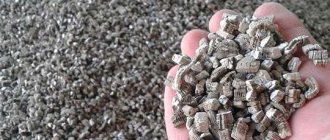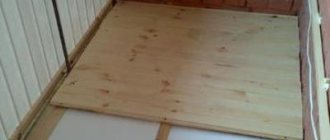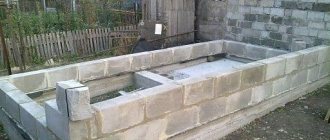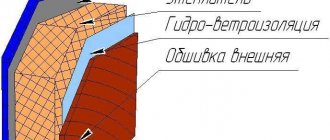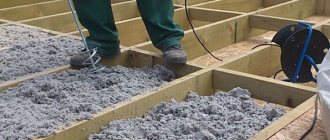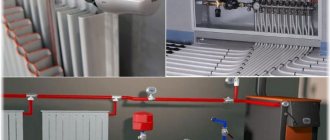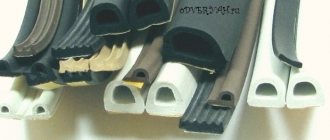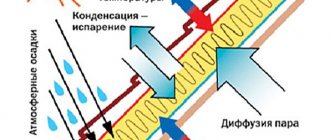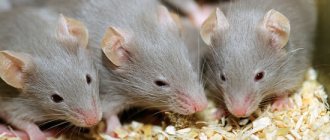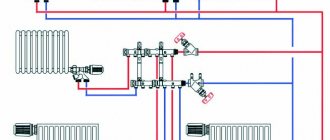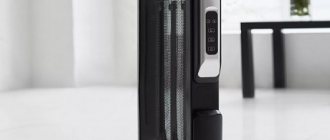How is mineral wool different from polystyrene foam?
Attention! The term mineral wool refers to several types of insulation materials; for more details, see the material: Technical characteristics of mineral wool, its brands and selection criteria. In this article we will talk specifically about mineral basalt wool, because only its properties can be compared with polystyrene foam and a choice can be made. All other types of mineral wool will be inferior to both basalt wool and expanded polystyrene.
Ability to pass steam
The vapor permeability coefficient of both regular and extruded polystyrene foam is 0.03 mg/(m·h·Pa). For mineral wool this figure is 10 times higher. This means that it has a better ability to pass evaporated water. Although in practice, wall insulation consists of several layers with different vapor permeability. The final vapor permeability will correspond to the characteristics of the material for which it is minimal. Therefore, different types of insulation are closer to each other.
If the insulation system has a polymer structure, then mineral wool should not be used. The fact is that both the base of the system and the outer layer, made of polymer, do not allow moisture to pass through well. If condensation gets inside, saturating the layer of mineral wool, then the water will not be able to evaporate, and the insulation will lose its thermal insulation properties.
After all, if you wet the cotton even slightly, it will not hold heat well. Therefore, when insulating a house, you need to be guided by the rule: a good vapor barrier must be made on the side of the house, and material with greater vapor barrier must be laid closer to the outer walls. This way, excess moisture will go outside.
Polystyrene foam does not allow steam to pass through, but does not accumulate steam either. Steam penetrating from the side of the room is usually discharged through the joints and irregularities of the insulation.
This property can be both a plus and a minus, so here, as they say, it’s a draw.
Ability to resist fire
Here, mineral wool has a clear advantage - because this material does not burn at all. Note that some types of basalt fiber wool can withstand ambient temperatures of up to 1000 degrees. Celsius. Expanded polystyrene not only melts easily, but is also capable of burning on its own. Some may argue that fire retardants are added to polystyrene foam, which prevent it from maintaining combustion. Yes, they are absolutely right, but their effect wears off over time and the foam begins to support combustion. And here is a video clearly demonstrating what happens when extruded polystyrene foam, basalt wool, polystyrene foam, polyurethane foam and ecowool burn.
Video. How do insulation burn?
Mineral wool + |Foam plastic -
Question of price
In this parameter, both insulation materials are approximately equal. The cost of both basalt rock mineral wool and polystyrene foam varies depending on their density. This indicator also affects the brand.
What is more convenient to install
Expanded polystyrene (both regular and extruded) is stronger and more resilient than mineral wool. It is easy to cut and sand. However, it is quite problematic to glue this insulation in such a way as to avoid the appearance of cold bridges at the joints of individual elements. This problem is solved by using foam sheets with an L-shaped edge. Mineral wool can be dense and elastic only in mats laid in the frame and on the facade. But the joints of its sheets are so small that there can be no question of cold bridges.
Mineral wool + - |Foam plastic +
Ability to resist heat loss
As already mentioned, manufacturers indicate almost identical values for the thermal conductivity coefficients of mineral wool and polystyrene foam. Experimentally, it was possible to find out that polystyrene foam still gives better results when insulating. The fact is that only very dense basalt wool, produced in the form of slabs, has the same thermal conductivity. But the rolled material, which becomes looser after rolling, is inferior to expanded polystyrene in terms of thermal insulation properties.
After all, the PPS inside is a set of closed cells with air. This structure allows the material to retain heat very well.
But mineral wool releases warm air outside - because it does not have insulated cells. As a result of convection, layers of air move from the warm side of the insulator to the cold (outer) side. As a result, a room insulated with mineral wool cools faster than one insulated with polystyrene foam.
Any polystyrene foam, even the most inexpensive one, works better than mineral wool as a heat insulator. After all, all manufacturers of refrigeration equipment and water heating devices choose it for insulation. If these insulation materials are used together (in multilayer thermal insulation), then polystyrene foam should not be located outside. Otherwise, the requirement to increase vapor permeability from the inside of the walls to the outside will not be met. To meet this condition, the outer layer must be mineral wool. It seems that the answer to the question is now clear: what is warmer - polystyrene foam or mineral wool.
Minvata - | Foam +
On the issue of environmental friendliness
Previously, polystyrene foam was made from styrene, and freon was used in the production process. This material was not suitable for use inside homes, as it emitted harmful gases. But now more stringent requirements are imposed on the environmental friendliness of materials. Both European and Russian manufacturers have stopped using freon to make foam plastic. Therefore, it is absolutely safe for outdoor use, in any quantity, but indoors it should be used carefully - without being too carried away with quantity.
Minvata + | Styrofoam -
About the service life of polystyrene foam and mineral wool
You can often hear or read that after 8 or 10 years the foam begins to deteriorate. But this only happens if the material does not have any protective coating. And then rain, snow and sun rays (especially) can really damage the foam. But in thermal insulation systems, PPS usually has a decorative coating on top. And the moisture formed as a result of the settling of condensate leaves it through moisture transfer. Old refrigerators are made of foam and nothing has been done in 30 years. And German houses insulated with it last for 35 years (Polish – 20 years, Baltic – 15 years). Let's keep this in mind when deciding what to choose - polystyrene foam or mineral wool.
As for basalt wool, its fibers are made from volcanic rocks, so they are not afraid of various aggressive environments, which naturally affects the great durability of this material.
Minvata + | Styrofoam -
In addition to regular polystyrene foam, there is also extruded polystyrene foam, which is superior in performance to both simple polystyrene foam and mineral wool. The EPS inside has identical cells, evenly spaced. It can be used not only for insulating floors, walls and roofs, but also for the construction of various buildings and structures, as well as roads. Extruded polystyrene foam is used not only in the construction of private houses, but also on an industrial scale.
Hygroscopicity of mineral wool and polystyrene
This is what installation errors lead to.
The second no less significant factor that will help determine whether foam plastic or mineral wool is better for insulation is hygroscopicity (the ability of the material to absorb moisture). Moisture absorption is measured as a percentage of the weight of the material per day. That is, how much moisture, as a percentage of its own mass, is absorbed by the insulation when immersed in water for 24 hours. Stated characteristics:
- polystyrene foam no more than 1%;
- extruded polystyrene foam 0.04%;
- mineral wool 1.5%.
The degree of water absorption of the insulation determines the possible areas of its application. For example, EPS practically does not absorb moisture, which is why it is used for laying in the ground. Polystyrene foam begins to crumble from moisture, and mineral wool, once wet, does not retain heat at all, so it is not of much use either. At the same time, based only on the hygroscopicity of materials, it is impossible to determine whether it is better to insulate a house with foam plastic or mineral wool. The issue must be considered holistically and the following characteristic is important.
There are long-burning coal stoves for homes that are heated using the convection method, and there are those with a built-in heat exchanger for water heating.
You can read about how the Buleryan stove works here.
What is better to insulate with polystyrene foam?
This material has proven itself very well in places where air humidity is quite high but insulation is required.
- Foam plastic will not do anything when in contact with wet ground, so it can perfectly insulate foundations, as well as various engineering structures located underground. Tens of years will pass, and the insulation will remain the same as at the very beginning. It is often used in the construction of multi-layer foundations as a middle layer. It turns out to be a very reliable and high-quality foundation.
- When building houses without basements, on a monolithic foundation, it is also convenient to use polystyrene foam. Plates of this material are laid on a leveled area, and then a layer of concrete is poured on top of them. The slabs themselves can be either one row or several. After the concrete has hardened, the walls of the house begin to be erected.
- To prevent the foundation of the house from freezing, it is very effective to insulate not only its vertical, but also its horizontal part with polystyrene foam. Expanded polystyrene slabs are laid along the foundation. Then they are backfilled, if necessary, additionally laying a waterproofing layer. This method of insulation reliably protects the foundation from frost.
- The walls of houses (both inside and outside) can also be effectively insulated with polystyrene foam. It is best if these walls are block or brick. A high thermal insulation effect is achieved when using polystyrene foam to insulate interior spaces, and the formation of a dew point is not observed.
- For non-ventilated roofs (warm, flat roofs), the PSBS grade of expanded polystyrene is used. A waterproofing layer must be placed on top. For cold roofs that are ventilated, thermal insulation is carried out differently. The inside of the roof is insulated with polystyrene foam, leaving space for ventilation. This prevents water vapor from condensing.
- It is also good to insulate floors and ceilings between floors with foam boards. A layer of insulating material is placed under them, and concrete is poured on top.
- A variety of packaging is also made from polystyrene foam, and it is also used for thermal insulation of refrigerators, freezers and special isothermal vans.
Thermal conductivity
The thermal conductivity indicator is considered to be the amount of heat passing per meter of depth and area of the material, decreasing by 1 degree Celsius. The thermal conductivity coefficient is written as W/m*K (Watt per meter Kelvin). To select insulation, the lower the coefficient, the more effectively it retains heat or keeps out the cold.
So, what is better to use, mineral wool or polystyrene foam, when comparing their thermal conductivity coefficients?
| Material | Thermal conductivity, W/m*K |
| Styrofoam | 0,033 – 0,037 |
| EPS (extruded polystyrene foam) | 0,029 – 0,034 |
| Mineral wool | 0,036 – 0,045 |
Obviously, the difference in characteristics is small. But in this case, the decisive factor will be the behavior of the material during deformation. If you compress mineral wool, it will lose its properties. For EPPS, compression is generally provided because it is used to insulate the foundation by laying it at depth.
So, what is warmer: 50 mm polystyrene foam or 50 mm mineral wool? If we compare the numbers, we can come to the conclusion that ordinary foam plastic does not lag behind in thermal conductivity (we do not take polystyrene foam into account, given the specifics of its use).
What is better to insulate with mineral wool?
- For wooden houses you don’t have to choose which is better - polystyrene foam or mineral wool. “Breathing” wooden walls cannot be insulated with foam plastic - this will negate their beneficial properties. Therefore, they are insulated with mineral wool. And in buildings built from other materials, partitions, floors, ceilings, and ceilings are sheathed with mineral wool. If external walls are insulated, then a ventilated façade of a suspended type is made. Vapor barrier membranes are an integral part of this design.
- Mineral wool is used to insulate attics, attics and floors of houses, and pitched roofs. At the same time, be sure to leave space for ventilation.
- Brick houses with a small number of floors, in which the middle thermal insulation layer is mineral wool. It is also used for three-layer panels made of concrete, reinforced concrete, as well as sandwich panels in a metal shell.
- They are used in places where it is necessary to provide good protection from very hot objects, since basalt wool can withstand temperatures up to 1000 0C.
- Frame buildings of any type are best insulated with mineral wool. In addition, it is also used for sound insulation. Moreover, this material is well suited for horizontal, vertical, and curved surfaces.
- Mineral fiber wool, produced in the form of soft slabs, can be used to wrap heat, water and gas pipes. It is also used to insulate industrial equipment in enterprises.
If you notice an error, a non-working video or link, please select a piece of text and press Ctrl+Enter .
0
Which material is better in use?
Polystyrenes burn, the house can burst into flames like a match.
In principle, the installation is almost identical, so there is no particular difference whether mineral wool or polystyrene foam is used. What shows itself better during operation is another question. Here we will look at several aspects:
- shrinkage;
- fire safety;
- toxicity;
- mice.
Polystyrene foam and its derivatives do not shrink at all. Low density mineral wool can settle, but at a density above 85 kg/m. a cube and a wall height of up to 3 meters is unlikely. If you select thermal insulation according to manufacturers’ recommendations and adhere to the correct installation technology, then this problem will be completely eliminated.
Polystyrene foam and EPS cannot boast of fire safety. Both materials support combustion and at the same time produce toxic smoke. You need to be extremely careful with this material; if a fire occurs, the insulation will burn out very quickly. Mineral wool does not burn at all; it can withstand temperatures of 750 degrees. It is even used to insulate chimneys. Foam plastics are toxic and full of carcinogens, no matter what marketers say about its environmental friendliness. Many types of mineral wool are also harmful, as they contain phenol formaldehyde, while there are acrylic-based materials that are absolutely safe.
Another problem is mice. They successfully live in both foam plastics and mineral wool, although they prefer polystyrenes. In the book “10 thousand tips and teachings for all occasions” from the 1955 cartoon “The Enchanted Boy,” little Nils read: “To get rid of rats and mice once and for all, it is best to buy a young and healthy cat.” The advice is still relevant today.
Video description
For a detailed comparative review of insulation, see the video:
To summarize, we can confidently say that when choosing expanded polystyrene or mineral wool which is better for insulating a house, there cannot be a definite answer; you need to select the type of insulation in accordance with the set of parameters of the structure itself and subsequent operation. It is important to remember that there are neither bad nor good insulation materials, but there are materials that were incorrectly selected and poorly installed.
High-quality insulation of house walls Source www.promstan.com.ua
After all, even the best material, if installed unskilled, has a high chance of losing its performance properties and characteristics. When choosing, it is important not to chase the lowest price, but to give preference to trusted manufacturers who have proven themselves well in the building materials market.
Technical characteristics of polystyrene foam and its advantages
Polystyrene foam is used as insulation for walls, ceilings, floors of both private houses and apartments, and their balconies and loggias. The material is characterized by low specific gravity, resistance to moisture and rotting processes. Its only drawback is flammability, however, by applying a layer of plaster, this drawback can be avoided. Also, self-extinguishing types of foam are now common.
Polystyrene foam is produced in the form of square slabs with parameters of 1 m*1 m or 1 m*1.2 m. The thickness of the foam can vary from 2 cm to 10 cm, depending on the scope of application. It has the following properties and advantages:
The properties of foam plastic as insulation make it a universal material for a wide range of construction works
- Thermal insulation . Low thermal conductivity coefficient (from 0.037 to 0.041 W/mK) provides high thermal insulation performance. The porous structure completely eliminates heat loss.
- Compatibility with other materials . This advantage allows you to cover the foam with any plaster mixtures.
- The long service life allows the material to be used as insulation for up to 50 years.
- Absorption of sounds . Polystyrene foam is often used as a soundproofing material.
- Resistant to mechanical stress and sudden temperature changes.
Important: Polyfoam does not like direct sunlight. Regular exposure to them contributes to the destruction of the top layer and, as a result, deterioration of technical characteristics.
What is better to use for foundation insulation?
The construction of the foundation of a house is often associated with the need to insulate it. If the walls of a private house are well insulated, but the foundation and floor of the first floor are cold, then heat leaks are inevitable, as well as a violation of the comfortable atmosphere in the house. A foundation protected from heat loss provides:
- reduction of heat loss;
- reducing home heating costs;
- preventing dew point changes;
- stabilization of temperature values in residential premises;
- protection from environmental influences.
Insulation of the foundation is possible in two options. The first is placing a heat-insulating layer around the perimeter of the house on top of the foundation.
Foundation insulation with foam plastic Source static.tildacdn.com
